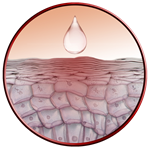 |
Oral & Gingival care
|
CONTEXT
Similarly to all other non-validated tests, users are completely free to develop their own protocol and thus to get test perfectly adapted to their specific needs. This includes thus a multitude of possibility regarding protocol steps (pre-incubation, application, rinsing…) and used endpoints (biochemistry, molecular biology, OMICS, cell imaging...). Moreover the main advantage is the possibility to use well-known references as positive and negative control that may be different from regulatory toxicological ones.
DESCRIPTION
The availability of both oral epithelium and gingival epithelium that mimic the human in vivo corresponding tissues is a real advantage for oral care research purposes. Previous results have demonstrated that similarly to the in vivo situation our cornified gingival model is more resistant than the oral epithelium model.
For example, a toothpaste or a dental material can thus be well-tolerated by the gingival epithelium and not by the oral epithelium and another product well-tolerated by both tissues.
Moreover, our oral epithelium is also a good model for bacterial adhesion research projects.
Example of applications:
- Toothpaste development
- Mouthwash solution developement
- Oral candidosis treatment/understanding
- Dental material assessment
MODELS
DETAILED ASSAY PROCEDURE
REFERENCES
Secreted aspartic proteinase (Sap) activity contributes to tissue damage in a model of human oral candidosis. M. Schaller, H. C. Korting, W. Schäfer, J. Bastert, W. Chen, B. Hube. Molecular microbiology, 34: 169-180, 1999.
Release of prostaglandin E2, IL-6 and IL-8 from human oral epithelial culture models after exposure to compounds of dental materials. G. Schmaltz, H. Schweikl, K.-A. Hiller. European journal of Oral Sciences, 108: 442-448, 2000.
Effects of the Human Immunodeficiency Virus (HIV) proteinase inhibitors saquinavir and indinavir on in vitro activities of secreted aspartyl proteinases of Candida albicans isolates from HIV-infected patients. H. C. Korting, M. Schaller, G. Eder, G. Hamm, U. Böhmer, B. Hube. Antimicrobial Agents and Chemotherapy, 43: 2038-2042, 1999.
Polymorphonuclear leukocytes (PMNs) induce protective Th1-type cytokine epithelial responses in an in vitro model of oral candidiasis. M. Schaller, U. Boeld, S. Oberbauer, G. Hamm, B. Hube, H. C. Korting. Microbiology, 150: 2807-2813, 2004.
The use of three-dimensional oral mucosa cell cultures to assess the toxicity of soldered and welded wires. B. Vande Vannet, J.-L. Hanssens, H. Wehrbein. European Journal of Orthodontics, 29: 60-66, 2007.
Toxicity of used orthodontic archwires assessed by three-dimensional cell culture. B. Vande Vannet, N. Mohebbian, H. Wehrbein. European Journal of Orthodontics, 28: 426-432, 2006.